The Bleak and Beautiful Galápagos
It’s mating season on the beach of North Seymour, one of the smaller of the Galápagos Islands, and I’m watching one of the ridiculously comical male blue-footed boobies performing his mating dance. He kicks up his webbed blue feet one at a time, points his beak at the sky, spreads his wings, and whistles like a construction worker. Quite a show. Nearby, a female booby watches with seeming indifference while discreetly taking note of her suitor’s feet. The bluer they are, the healthier he is, and that’s why he’s showing them off. Finally, she answers his whistle with a honk. For a booby, that’s amore.
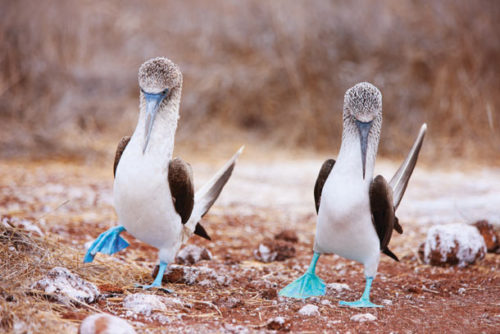
More avian love is in the air. A male frigate bird has puffed out his brilliant red breast to the size of a football, tilting his head back for the full display.
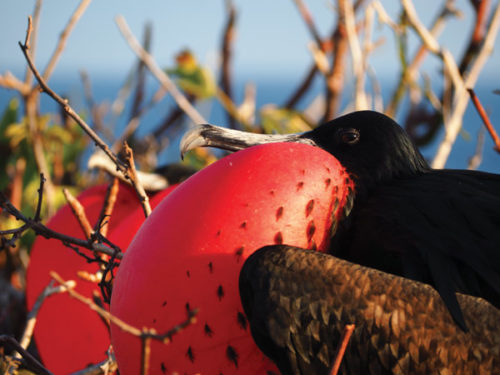
Joshua E. Bush
Our guide to this extraordinary spectacle reminds us not to walk too close to the mating birds, but the plain fact is they’re oblivious to the human intrusion. It’s as if we are invisible to them.
It’s understandable that most people believe the Galápagos Islands are a lush, tropical paradise teeming with wildlife. You’ve heard about the giant tortoises, certainly. And maybe you’ve also heard about the clownish boobies and other exotic birds that nest there. But what you might not know is that the archipelago of 13 large islands, 6 smaller islands, and over 40 islets collectively known as the Galápagos are all dormant volcanoes thrusting their barren peaks up from the sea. In truth, these islands are anything but lush. On many, the landscape is bleak — all black lava with very little soil, no rain for months at a time, and hardly any natural source of potable water — and lambasted daily by the sun. What little vegetation has taken hold needs to be extremely hardy. Same for the animals. But the reward for being able to survive in this desolate landscape and in this unforgiving climate is that there are few natural predators. And the reward for humans who visit is that the creatures of the Galápagos don’t fear us, because they have no experience with fear, no genetic memory of needing to flee, fight, or hide in order to survive.

We associate the islands with Darwin, who studied finches when he arrived here in 1835. (As for the giant tortoises, sorry to say, the young naturalist had no compunction about dining on them, as was common practice at the time.) Darwin’s finches are thought to have arrived at the islands after being blown offshore centuries earlier. As you may remember from high school biology, the importance of the finches was that, in their continued isolation, not just from the mainland, but from each other on different islands in the archipelago, they evolved into several distinct species. This observation would lead to Darwin’s theory of evolution as described in The Origin of Species, published in 1859.
Herman Melville’s travels also brought him here in 1841. Thirteen years later, he published a popular novella about the region, The Encantadas, or The Enchanted Isles. (At the time, the name was understood to mean “bewitched” rather than “magical.”) Melville was horrified by what he saw: “Take five-and-twenty heaps of cinders dumped here and there in an outside city lot; imagine some of them magnified into mountains … and you will have a fit idea of the general aspect of the Encantadas. … To them change never comes; neither the change of seasons nor of sorrows. Cut by the Equator, they know not autumn, and they know not spring; while already reduced to the lees of fire, ruin itself cannot work more upon them … they are cracked by an everlasting drought beneath a torrid sky.”
Now, at the risk of contradicting one of our greatest writers, I have to say that, in their fearsome bleakness, the islands actually are extraordinarily beautiful — a beauty that stems in part from being unspoiled by man. Those who arrived here in the colonial era with intent to plunder simply couldn’t cut it. Credit not just the harsh climate and lack of water but also the unreliable currents and equatorial doldrums for making the region so difficult to navigate in a sailing ship that these islands were never good candidates for colonization. In a turnabout, today it is man — under the auspices of the Ecuadorian government — who is protecting the region from being spoiled.

Joshua E. Bush
I’ve come to the Galápagos onboard the Endeavor II, operated by National Geographic Expeditions in partnership with Lindblad Expeditions. Their fleet of seven small ships, carrying no more than 62 to 148 guests, take travelers to out-of-the-way places like the Galápagos, Antarctica, and Alaska’s inside passage. On our ship, one of the newest of the fleet, 79 passengers travel in extreme comfort with 58 staffers, including several naturalists, a photography expert, snorkel guides, videographer, plus cooks, servers, cleaning staff, and ship’s captain and crew. But, despite the amenities, the vibe is strikingly different from that of a large cruise ship. As our expedition leader (and sometimes den mother) Cindy Manning announces via shipwide intercom soon after we embark, we are decidedly “not on a vacation.” This is a true expedition, she reminds us (somewhat unnecessarily since no one comes to the Galápagos to lounge by a pool), with lots to do, lots to learn. The days start early — some of the morning excursions ashore depart as early as 6:30 in order to avoid the heat — and continue with lectures at noon, maybe a snorkel trip in the afternoon, and another shore excursion or hike before dinner. See a sample entry from my journal (below).
On one very special morning, I join a walk billed as a photography session along the beach on Santiago Island. Within minutes of landing, we come upon a sea tortoise laying her eggs barely hidden in the sparse mangrove trees just off the beach. She’s been laying all night, and we’ve encountered her in the process of covering them up, her huge flippers tossing up great plumes of sand. We keep a respectful distance and click away. When she finishes, she drags herself slowly, with huge effort, back to the sea, clearly exhausted. We learn later that these turtles lay 80-200 eggs at a time, a process that takes all night. Only one in a thousand eggs survives the birds, snakes, and iguanas that dine on them. Unlike in some other locales, here the park rangers do nothing to protect the eggs, regarding that as interfering with nature.
Part of the magic of the Galápagos is a sense of stepping back in time and grasping the relative unimportance of man and the brevity of human life in the history of the planet. We certainly lose our connection to the natural world in our day-to-day lives. But now, transported back through the eons in this unspoiled setting, the concerns of one’s own small life have, for a time, faded away. Instead, in even briefly observing these extraordinary creatures in their natural habitat, we can fully share Darwin’s conviction that “the love for all living creatures is the most noble attribute of man.”
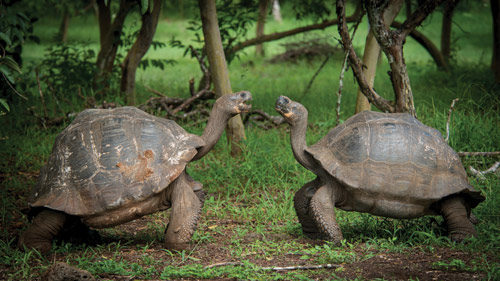
Joshua E. Bush
A Typical Day
Sample entry from the author’s journal
Tuesday morning: Our ship traveled overnight around the northern tip of Isabela Island to Fernandina, the westernmost island in the archipelago, and also the youngest at 500,000 years old. With ship anchored a few hundred yards offshore, embark zodiacs (small inflatable boats) at 6:30 a.m. Above us the dormant volcano rises to nearly 5,000 feet, its flanks streaked with fresh lava flows, black and lifeless. Getting off the craft, we cross solid black slabs of “ropy” lava. Slippery when wet.
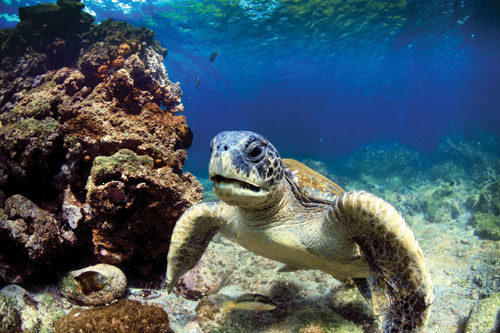
Joshua E. Bush
Step carefully over and around hundreds of prehistoric-looking, black marine iguanas that lie basking in the sun and are disinclined to move just because humans are present. They need to warm their bodies to 40°C (about 104°F) before they can go in the water to feed. Occasionally one of them will seem to “sneeze” out a white spray that coats their heads white. These unique creatures possess a gland in their skull that allows them to drink sea water and expel the salt through a portal above their eyes.

Joshua E. Bush
Sea lions playing along the water’s edge or sleeping half immersed in water on the sandy beach. A young sea lion nursing just yards away from us, indifferent to human presence.
A group of four flightless cormorants. With no natural predators, no need to fly. Evolved oversized webbed feet for diving and tiny wings used only for balance as they hop from rock
to rock along the shore.
Back on the ship. Lecture at noon on plate tectonics. The hotspot on the sea floor that produced the volcanoes of the Galápagos remained stationary while the plates shifted eastward, producing a series of islands roughly along a line. I picture the plate sliding and the volcanoes popping up in a neat row over 2 million years.
Afternoon: Over lunchtime, ship has moved us a short distance to a harbor on Isabela Island, the largest island in the chain. We hop back on the zodiacs for a snorkel trip along the shore, below a cliff face. Before departing, we spy three hammerhead sharks, their long white forms shimmering in the crystal water, patrolling the area around the ship. Will we see them in the water?

Learn there may be sea turtles in the area. Dive in, and there’s nothing at first. A couple minutes later: large form in the water. Humongous sea turtle (shell about three feet in diameter) coming directly at me. About two feet away, it seems suddenly to notice the human intrusion and descends just low enough to pass beneath me, like a truck pulling around a parked car. Moments later, a group of four turtles, then suddenly too many to count. Amazing!
Penguins swimming super fast underwater. Try to keep up. Can’t. Then, some young sea lions playing, swirling around end over end. An adult sea lion surges up from the deep, chasing a blowfish. It plays with the fish at the surface, just a few yards away from me, but then the fish inflates. Sea lion seems to lose interest and swims away.
No sign of sharks.
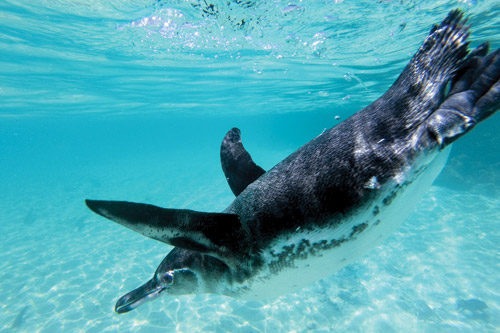
Late afternoon: Another zodiac excursion, planned for those who don’t snorkel. I hop aboard to get the surface view. Multitude of sea turtles, just below the surface, making beautiful patterns in the water. Startling us, a sea lion pops out of the water, halfway into the boat, splashing us, seeming to want to come aboard. Try to snap picture, but just get half his head as he slides back into the water. Later, a hike, dinner (Ecuadorian barbecue), early to bed.
Steven Slon is the editorial director for The Saturday Evening Post. His last article for the Post was a profile of racecar driver Mario Andretti in the May/June issue.
This article is featured in the September/October 2017 issue of The Saturday Evening Post. Subscribe to the magazine for more art, inspiring stories, fiction, humor, and features from our archives.